Are you looking to add waterfowl to your flock? With their entertaining antics and delightful personalities, they are a fantastic addition to any poultry-loving property. However, it is important that you choose the right species and breed for your farm or backyard. In this blog, we explore the various waterfowl that we offer in the store so that you can be confident in making your purchase.
If you would like to order waterfowl, as well as chicks, keets, poults, or game birds, simply refer to our 2021 Chick Season Guide for a complete listing of breeds.
Geese
Domestic geese have been raised for eggs, meat, feathers, and their pastoral beauty for over 2,000 years. Some farms even use them to guard their flocks of chickens, helping to deter predators. A gaggle of geese is a wonderful addition to any homestead!
African Goslings
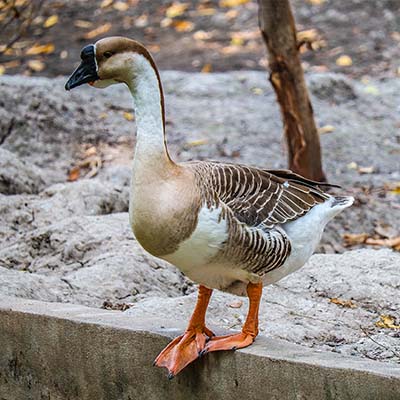
Introduced to the United States in the mid-1800s, African Geese are curious, energetic birds that make good property protectors or watchdogs. These strikingly beautiful birds have grey feathers with white stomachs and a dark stripe down their necks. They are often characterized by the large black knob on the top of their beak. African Geese are active foragers and can be a bit noisier than other goose breeds. They are considered medium-sized geese; adults will mature at 12.5-15.5 lb. Females will lay about 35-45 eggs each year.
American Buff Goslings
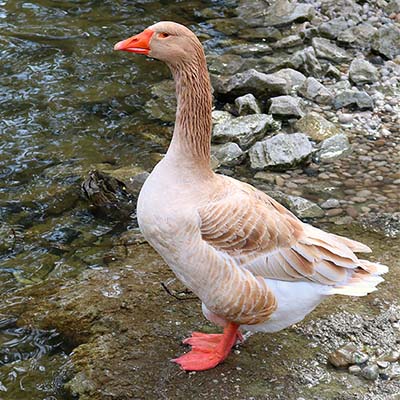
Unlike many other breeds, the American Buff geese have origins in the United States. “Buffs” are very calm and have a wonderful disposition. They are gentle around children and pets, making them the perfect addition to your backyard flock. Sometimes described as fawn or apricot-colored, they have buff-colored feathers along their back that are edged with creamy white. Typically, American Buff adults will mature at 14-16 lb. Females will lay 25-35 eggs each year.
Toulouse Gosling
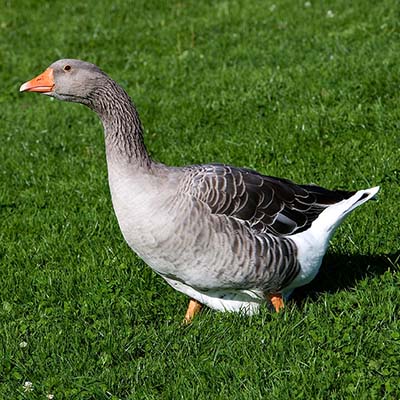
Toulouse Geese are the most popular commercial geese sold in America today. They produce excellent yields of goose down and all-dark meat. The varying shades of gray in the plumage emphasize their deep, rounded breasts and massive appearance. The Toulouse Goose has a large oval head, long neck, and a heavy body. They are a hefty breed and do not fly. They are slower growing than other geese and will not reach full maturity until at least 3 years of age. Their adult weights are 18-20 lb for males and 12-13 lb for females. Females will produce only 15-25 eggs each year, however, they make good foragers in large gardens and orchards. They are very docile and calm, making them great additions to the family flock.
Ducks
Both beautiful and entertaining birds, Ducks are a popular addition to many hobby farms and homesteads. Popularly raised for meat and eggs, they also make fantastic pets. They are extremely social birds, so we recommend raising a flock of at least three.
Indian Runner Ducklings

Originally referred to as the “penguin duck,” the Indian Runner duck became popular in Europe and America towards the end of the 19th century. They are primarily kept as egg-laying ducks and are also good for organic pest control. The Indian Runner is a lightweight breed of domestic duck with a slim body and long neck. The legs of the Indian Runner duck are set far back on their bodies, resulting in the upright carriage appearance of the breed. They come in a wide variety of colors, including, fawn, white, chocolate, blue, and black. The Indian Runner Duck usually requires less amount of water as compared to other duck varieties and can thrive with only a bucket of water to dip their heads into. At maturity, the Indian Runner Duck will weigh about 3.1-5.1 lb. They can lay up to 300 greenish-white eggs per year.
Blue Swedish Ducklings
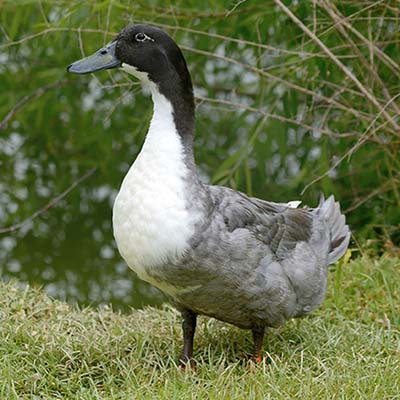
Developed in 1835 by the farmers in Pomerania, the Blue Swedish Duck was bred for domestic uses, such as for meat and egg production. These attractive ducks are known for their blue color and have a white bib that runs from under the bill down the breast, as well as white on their wings. The Blue Swedish Ducks are very calm and hardy, which makes them great beginner’s ducks. They love to forage and free-range and can be noisy in confinement. The Blue Swedish is a medium-sized bird: drakes will weigh up to 8 pounds and the hens will weigh up to 7 lb and lay up to 100-150 white eggs per year.
Buff Orpington Duckling
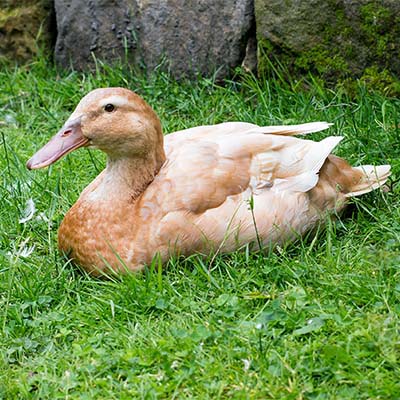
The Buff Orpington ducks originated from the famous Orpington Farms in England; Orpington Farms also developed the well-known Orpington chickens. They are extremely hardy and strong, and they make an ideal dual-purpose hen. They grow fast and are ready for market in 8 to 10 weeks. The hens are also very good layers, and naturally broody making them ideal for breeding. Buff Orpingtons are great for beginners and make excellent backyard pets; they are known to be gentle, friendly, energetic, talkative, and entertaining. Mature Buff Orpingtons will weigh about 7-8 lb. Hens will produce up to 220 white or tinted eggs each year.
Cayuga Duckling
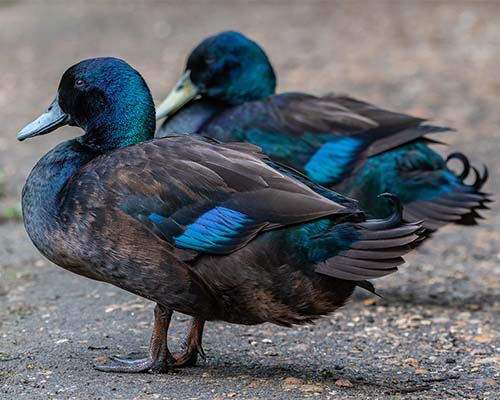
One of the few duck breeds originating in the United States, the Cayuga Duck comes from the Lake Cayuga region in upstate New York. Cayugas are quiet ducks, are very hardy, and are known primarily for their brilliant beetle-green coloring. They tolerate the harsh winters of the northeast and are still able to produce large broods of ducklings. Cayuga hens weigh around 4-5 lb and lay a dark egg at first, but as they age lay light blue or gray egg. They are a good laying duck, producing 100-220 eggs per year. Males average about 6 lb.
Domestic Mallard Duckling
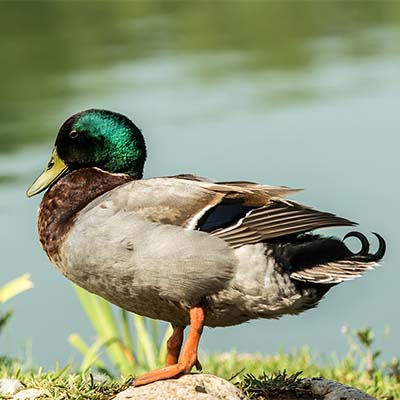
Mallards are a wild breed of duck that is native to most countries in the Northern Hemisphere. Mallards are small flying ducks that are excellent at hatching and brooding their own ducklings; sometimes they raise two different broods in a single year. They begin to fly for short spurts at 10-12 weeks old and fly very well by 16 weeks old. Males get their vibrant colors around this time as well. Being a strain descended from the wild, they are generally migratory birds and will fly away for the winter, returning in the spring to the same location. It is highly recommended that as winter and migration season approaches you keep them confined in a run for turnout rather than free-ranging. They are very hardy in all climates, so they winter well in New England. Once they are used to you, Mallards are calm ducks that are great entertainment, love to swim and forage for insects. An adult Mallard will weigh about 1.5–3.5 lb.
Please Note: All domestically hatched Mallard ducklings are required to be identified by U.S. Fish and Wildlife. Our ducklings will have a back toe removed by the hatchery upon hatch to identify them as domestically hatched.
Gold Star Hybrid Duckling
Developed in 1996, the Gold Star Hybrid is also known as the Golden 300 Hybrid. The Gold Star Hybrids were bred by crossing and utilizing the attributes of different duck breeds. They were designed for commercial flocks to lay more and larger eggs than the Khaki Campbell duck and have a calmer temperament with higher fertility. The males are shades of black and the females are shades of brown and can be sexed by color (they do not retain these characteristics in future generations). They are great for the family or commercial flock, producing high yields of eggs but also friendly insect control for your backyard. Gold Star Hybrids will mature around 4.5-5.75 lb; the females will lay approximately 200-290 eggs each year.
Khaki Campbell Duckling
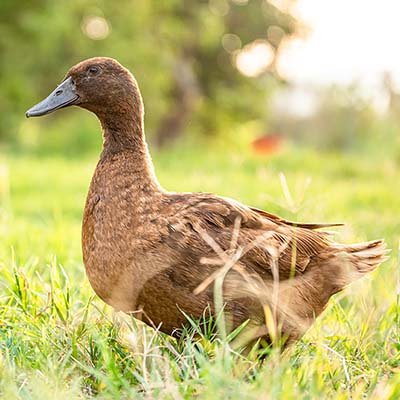
Introduced in 1901 by Mrs. Adele Campbell of Gloucestershire, England, Khaki Campbell Ducks are known as one of the best layers of all of the domestic ducks. Khaki Campbells are excellent foragers and withstand cool climates very well. They are very hardy but are also energetic and can be nervous if not interacted with. Some homesteaders use them as dual-purpose birds because they are easy to pluck and dress out at an average table size. They will have a mature weight of around 4.5 lb. A prolific layer, a female will lay about 340 eggs per year.
Welsh Harlequin Duckling

A fairly new breed, the Welsh Harlequin Duck was developed in 1949 by Leslie Bonnett of Wales. They are calm, inquisitive, and excellent foragers; Welch Harlequins are hardy in all climates. These ducks have excellent egg production abilities due to their Khaki Campbell background, yet retain the instinct to sit and hatch a nest full of ducklings. Welch Harlequins can also make an outstanding dressed bird as their under feathers are almost exclusively white making their carcass as pretty as a pure white bird. Interestingly, they can be sexed after hatching with a 90% accuracy by their bill color (darker bills normally indicate a male and light bills ending in a dark spot a female). Welch Harlequin Ducks weigh about 5-5.5 lb and females will lay about 150-200 eggs each year.
Giant White Pekin Duckling
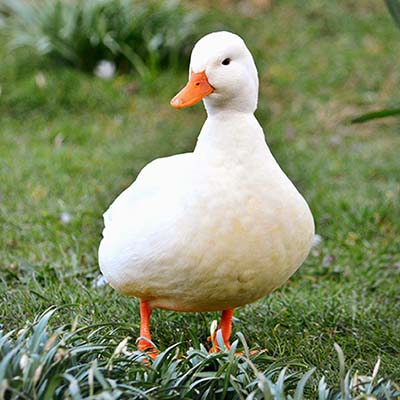
The Pekin Duck was brought to the United States in 1873, they are a popular domestic duck used primarily for egg and meat production. However, due to their friendly nature, more and more people are enjoying this breed as pets. Owners report that their friendly ducks follow them around as dogs would. They are entertaining and very active with a good hatching ability. The White Pekin duck has a fast growth rate making it an excellent choice for meat. Adult Pekin ducks weigh about 8-11 lb, females will lay about 150 eggs per year.
Fun Fact: The White Pekin breed of duck is the type of duck used in making the AFLAC commercials, and some say Donald Duck is modeled after a Pekin.
Silver Appleyard Duckling

Developed by Reginald Appleyard in England in the 1930s, Silver Appleyard Ducks are considered the most active foragers among the heavy weighted ducks. They are calm tempered with beautiful plumage colors including chestnut, silver-white, grey, brown, and buff which makes them excellent ornament ducks. Appleyards are also known for their exceptionally lean flavorful meat. These ducks are hardy in both hot and cold climates and have many purposes making them a perfect addition to any flock. When fully grown, the Silver Appleyard Duck will weigh 6-8 lb, hens will lay around 200-270 large, creamy white eggs each year.
Saxony Duckling

The Saxony Duck is a great multipurpose duck that originated in Eastern Germany in 1934. The breed was created using Rouen, German Pekin, and Blue Pomeranian ducks. Saxonys are docile and easy to handle, they are active foragers and excellent layers. They are one of the best large all-purpose breeds of ducks and adapt well to a wide range of environments. Drakes have the typical Mallard pattern, but with the distinct coloring of their blue-gray head, back, and wings. Females are buff with creamy white facial stripes and underbodies. Their mature adult weight is about 8-9 lb; Females will lay 190-240 large white eggs each year.
Do you need help deciding which duck breed or goose breed is right for you? Our experienced and knowledgeable sales staff is always ready to answer your questions. At The Cheshire Horse, we pride ourselves on being a fully-stocked horse and farm supply store and carry everything that you need to properly care for your gaggle or flock.
